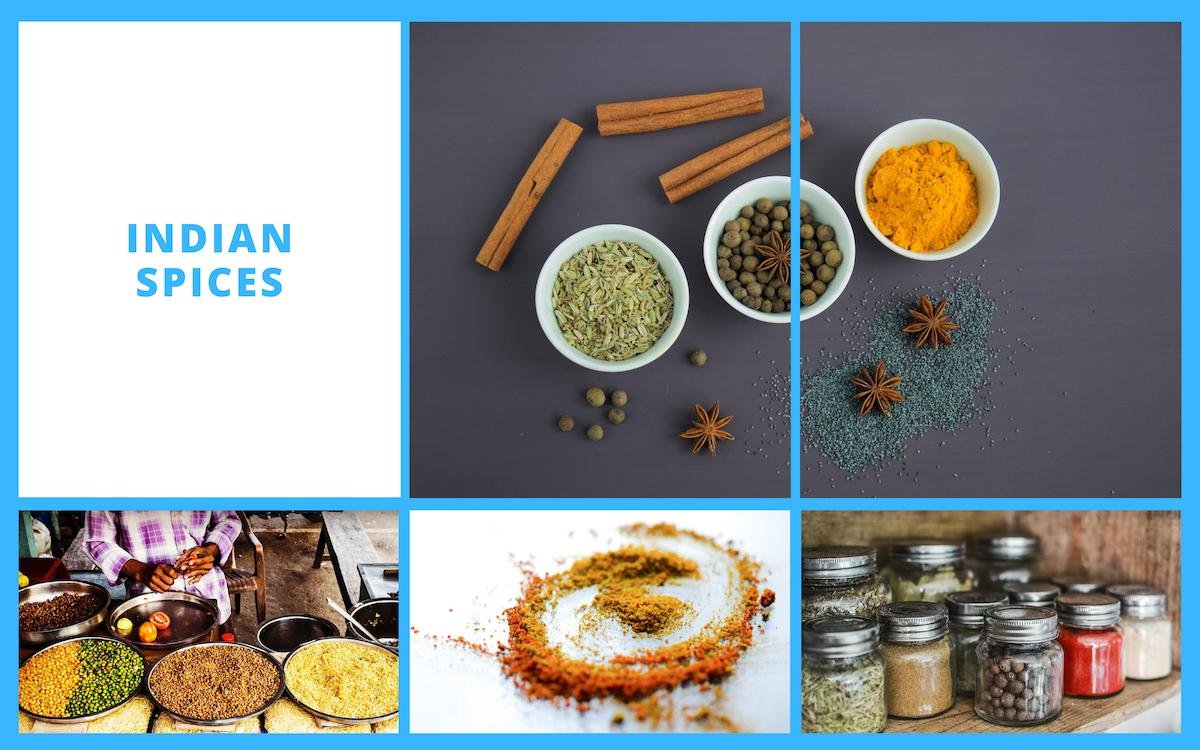
These are the top seven Indian spices to keep around so that you can make those flavorful food dishes from all over India.
Indian spices are the heart of the popular dishes from India.
Of course, India is a diverse nation, but seven regional spices will give you a national taste.
They are cardamom, garam masala, ginger, goda masala, panch phoran, rasam podi, and turmeric. Hailing from north, south, west, and east India, these spices are sure to satisfy whatever regional craving you will be having.
So, in this article, I will describe their names and show you pictures.
Likewise, I will look into the history and the benefits.
Finally, I will help you to order them!
Introduction
Spices in India are not like spices in most of the world.
There is a very intimate relationship between the Indian person and spices.
“In India, spices are used in a highly individual way, and daughters learn how to use them by observing their mothers or grandmothers,” explains Camellia Panjabi, author of The Great Curries of India.
A young chef-in-training in Jaipur, Rajasthan, explains her relationship with spices.
“At first, I was like any child,” remembers Divya. “I would ask my mother, ‘Mother, why does it taste like that?’”
Later, says Divya, she began exploring, and she realized she liked some of them and some she didn’t like.
Slowly, and over many years, Divya learned the power of the spices.
“I realized they could prevent and heal diseases,” she says. “They are medicine and more powerful than many of us know.”
Today, she is passionate about the spices and says she can’t wait to teach it to her daughter.
“In the future, when I have one,” she smiles.
Of course.
Description, Pictures, and Names – in English and Original
Because these are the essential Indian spices, they have also gone over to other regions.
For example, some of these spices are popular in neighboring places like Nepal, Pakistani, and Bangladesh.
So, I will start with a description and show you some pictures.
I will also tell you the names in both English and in the original languages.
Cardamom
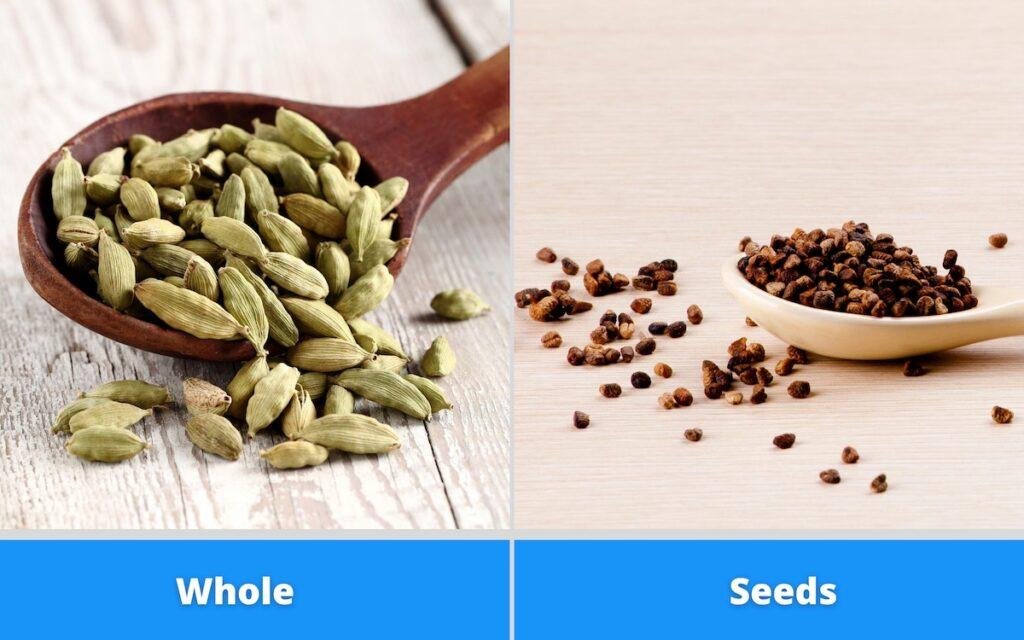
Cardamom is an English word.
In India, the spice is called differently in different regions.
For example, in northern regions, it is called ilaichee, which is Hindi.
On the other hand, in Tamil-speaking southern regions, it is called illakai.
In Begali-speaking eastern regions, it is known as elacha.
Finally, in Marathi-speaking western regions, it is velechi.
To this day, this is a spice that is not “common” in the West.
Of course, you can find it in most health food stores, but it is not easy to find it everywhere.
Meanwhile, in some countries like the United States, it is tough to find real or natural cardamom.
Instead, you get a “powder” mix that you don’t know how much of which is the real stuff.
Ideally, you want to get the whole cardamom, which is usually green, although there is black cardamom.
I’m not talking about black cardamom for now.
Then, you can use a spice grinder to get it powdered yourself.
So, this spice has a complex taste, and it is easy to use it in sweet or savory dishes.
It has both herbal and citrus taste!
Cardamom shows up is such an essential part of Indian cuisine.
According to K.P. Prabhakaran Nair, author of Agronomy and Economy of Black Pepper and Cardamom, this spice is king.
For example, Nair says the spice shows up in rice, vegetables, and even meat dishes.
“Cardamom can add a lingering sparkle to many dishes, both traditional and modern,” writes Nair.
However, I’m not asking you to keep cardamom in your kitchen to make outlandish dishes.
Instead, I’m asking you to get it for chai, the Indian tea.
It is one of the two primary ingredients, the other being ginger, which will cover next.
Divya Tip for Cardamom
Our chef-in-training Divya says there are many uses for cardamom, but there is one reason she extra loves this spice.
“I use it as a mouth freshener,” she says. “So, just pop a couple of seeds and let them hang out in your mouth.”
Many Indians believe this, but is it true?
Times of India, the country’s most popular newspaper, thinks so.
The paper says that this spice has antibacterial properties that help to neutralize dental bacteria.
“I knew it!” says Divya. “I swear, my mouth always feels so fresh after,” she adds. “I will usually pop about three of them and just leave them there until I feel like they are of no used any longer. Then I spit them out.”
Well, hello, cardamom!
So, our reader friend, will you try it?
Ginger
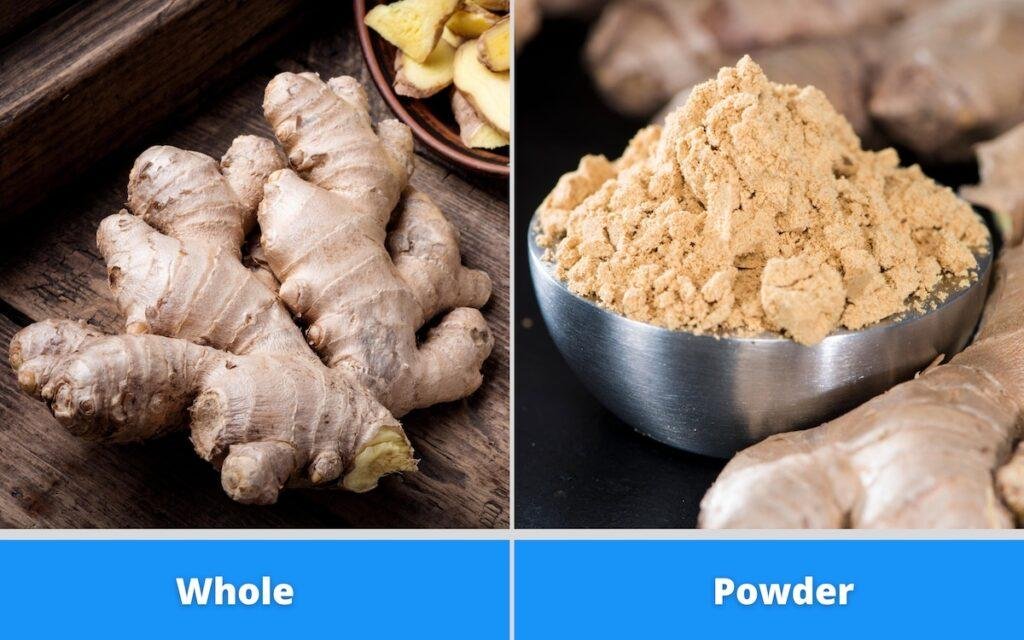
Okay, so this is not an unusual item in most western kitchens.
However, the use is different, of course.
In tea, ginger adds a sting of a taste that compliments the complexity of cardamom.
In other words, the spicy taste of ginger adds to the herbal flavor of cardamom.
As a result, they make a unique taste, a treat to the nose as it is to the tongue!
Ginger is called adrak in Hindi.
In Tamil, it is inchi.
However, it is a bit closer to Hindi with Bengali, and it is ada.
Finally, in Marathi it is ali.
A very famous dish is all ginger, called adrak ka achaar, which is a pickled ginger.
In other words, perfect in tea and in a pickle!
Talk about versatility.
Divya Tip for Ginger
Our friend Divya says there are many ways to enjoy ginger, but she recommends one specific way.
What is that?
She uses the stuff as a way to stay alert!
“It was my first year of college when I noticed this,” says Divya. “I would chew on small pieces of ginger, and I would stay awake.”
She says she went through those exams with flying colors!
Unfortunately, I couldn’t find anyone to corroborate this.
So, for now, I will take it as a cool Divya tip!
Turmeric

If you thought ginger was versatile, wait until you get to know turmeric.
In Hindi, turmeric is called haldi.
Bengali is closest to the Hindi with this, as this language calls turmeric haluda.
Likewise, Marathi language calls it harad.
On the other hand, Tamil speakers know this spice as manchal – very different.
No matter what they call them, most Indians are familiar with this spice.
And for a good reason, too!
“In Ayurvedic practices, turmeric is thought to have many medicinal properties—antiseptic, antibacterial, and anti-inflammation to name a few,” explains Madhu Gadia, the author of The Indian Vegan Kitchen.
So, of course, Indians put this in many different types of foods, including drinking it in tea form.
Another use is on the skin, especially for celebrations like weddings.
Finally, there are religious associations with this spice, as well.
In other words, it has many purposes in the Indian kitchen and life.
So, how can you incorporate it into your life?
Throw a bunch into your meals, during, or after cooking them.
Divya Tip for Turmeric
So, Divya swears by her use of turmeric for beauty.
“I will usually put on a turmeric mask twice per week,” she says. “If I’m breaking out, I can do it daily,” she adds. “Turmeric fixes any skin problem for me!”
Okay, to do this, Divya suggests mixing an equal amount of turmeric and honey and apply it on your face.
“Let it dry, which should take about 15 minutes,” she says.
Then you wash the face and voila, you’re ready.
So, is there really something to this?
Yes!
Chloe Metzger and Chelsea Hall talked to a doctor and wrote an article for Marie Claire.
They declared that turmeric and honey masks give you clear and radiant skin.
So, yeah, mask away as much as you want!
Garam Masala
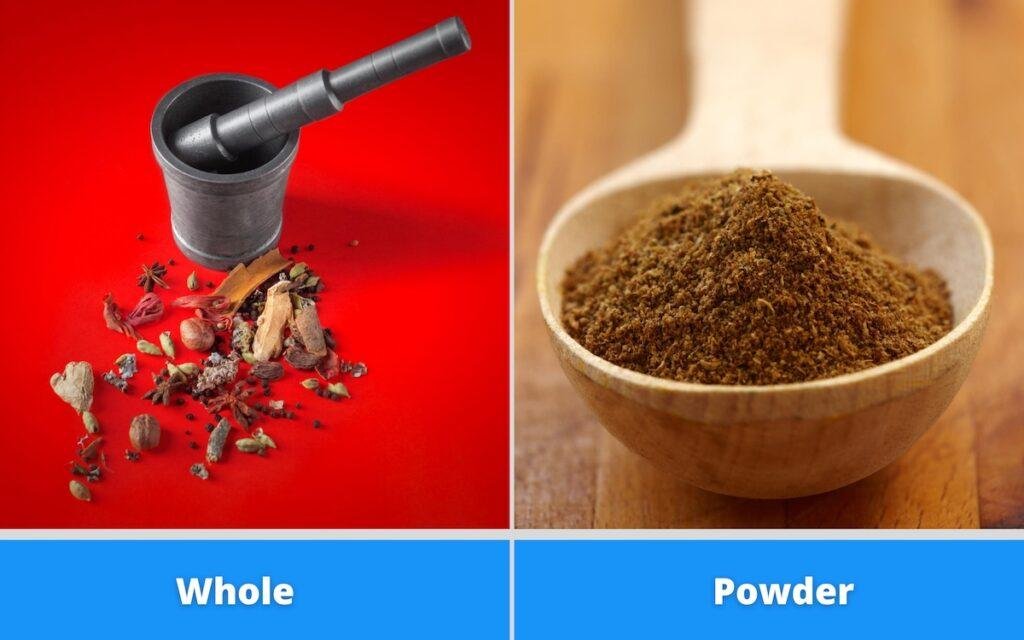
So, this is an opportunity for instruction in Indian cuisine.
Indian cuisine is composed of different regional cuisines, including northern, southern, western, and eastern.
As a result, each region has its own set of dishes.
However, each region also has its way to formulate popular dishes that you can find nationwide.
Hence, each region has its masala.
So, garam masala is a Hindi phrase that translates to “hot spice mix.”
It is what the rest of the world calls “curry” or “curry powder.”
Therefore, there are many types of “garam masala.”
It depends on the region!
For instance, the Punjabi garam masala in the far north is very different from the northwest’s Rajasthani garam masala.
Of course, both are different from the Tamil garam masala in the south.
Typically, if you only hear “garam masala,” it means it is the generic, northern-originated that some call “curry.”
Generally speaking, it is a mixture of cardamom, coriander, cumin, cinnamon, and pepper.
Of course, some recipes add turmeric, fenugreek, bay leaves, star anise, nutmeg, cloves, and more!
It just depends on where you are.
Now that I explained that let’s talk about other spice mixes from the regions.
So, how do you enjoy this?
Add a little bit to your rice, and you will get that “Indian food” flavor!
Rasam Podi
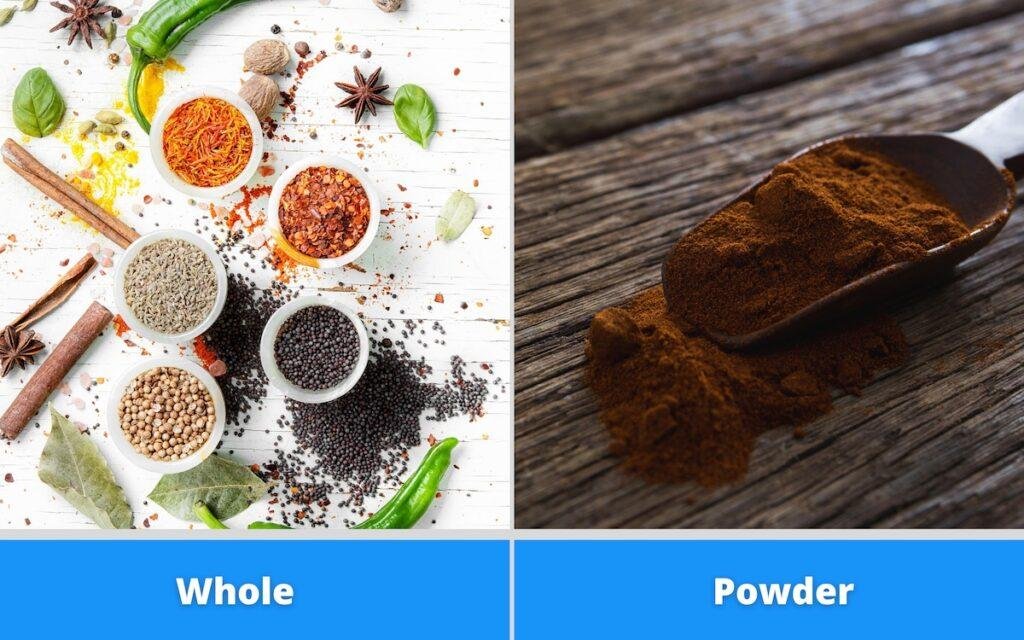
Rasam Podi is by far the quintessential Tamil spice mix.
Yes, rasam podi is a Tamil phrase that translates to “juice powder.”
That is because rasam, a popular dish, is a soup and is called “juice” in the Tamil language.
In other words, rasam podi is the powder mix with which you make the rasam soup!
But, of course, it is used in so much more.
“South India vegetarian dry spice mixtures often contain ground or whole ‘dals’ (lentils) and are used in sauces, soups, and curries and to enhance flavor and texture,” explains Susheela Raghavan, the author of Handbook of Spices, Seasonings, and Flavorings.
Meanwhile, rasam is an essential dish and is prevalent across the south.
In the Kannada language, it is called saaru, and, in Telegu, it is called chaaru.
So, rasam podi, called saaru pudi in Kannada, is popular in the entire region.
Again, it depends on different locales, but generally speaking, it has some primary ingredients.
For example, you will see cumin, coriander, pepper, fenugreek, and curry leaves as bases across the region.
So, how do you incorporate this?
Add it to a light soup, and you will feel like you made a trip to your South Indian restaurant!
Goda Masala
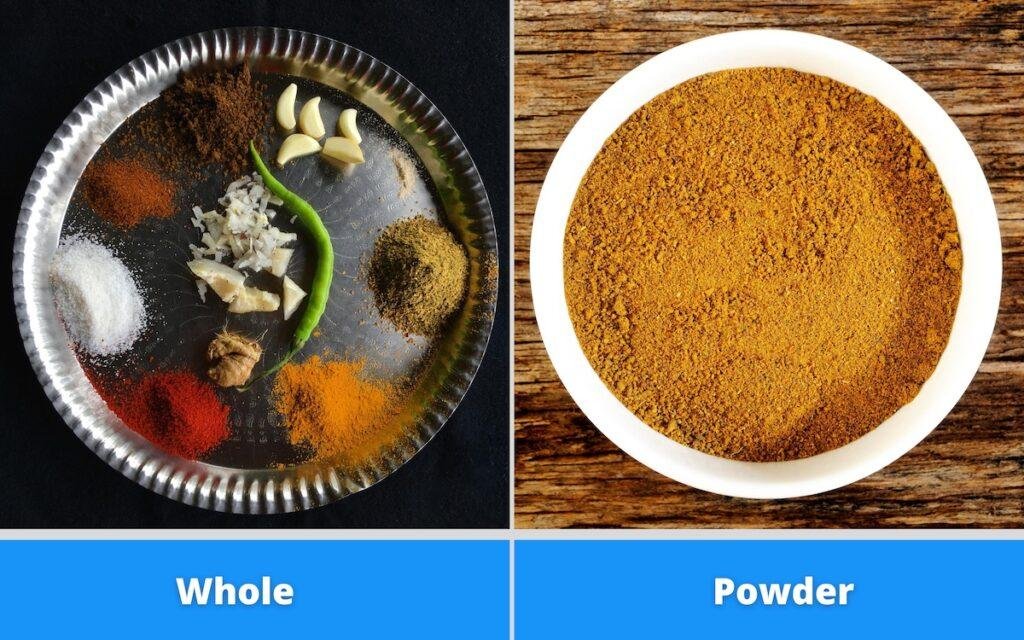
So, goda masala is a Marathi phrase meaning “sweet spice mix.”
Of course, there is no sugar, but the sweet is a reference to the aroma.
Nandu Marketkar, the author of Flavors of India for Tasty Palates, says this is a very different masala.
Marketkar argues that it “has a unique flavor and composition that is unmatched with any other combination of spices.”
Whereas other types of masalas have the ingredients toasted together, Marketkar notes goda requires roasting every component separately.
So, that is the secret to this Marathi mix!
The ingredients?
According to Marketkar, there are tons such as coriander, cumin, and sesame seeds.
Likewise, pepper, bay leaves, coconut, cloves, asafetida, and oil make the cut.
Therefore, it is a spice mix that can be considered a bit milder than garam masala.
So, how should you incorporate this into your diet?
If you have a lot of experience, try making Marathi dishes like misal pav.
Otherwise, treat it like garam masala and mix it with your general dishes, especially meat and rice dishes.
Panch Phoran
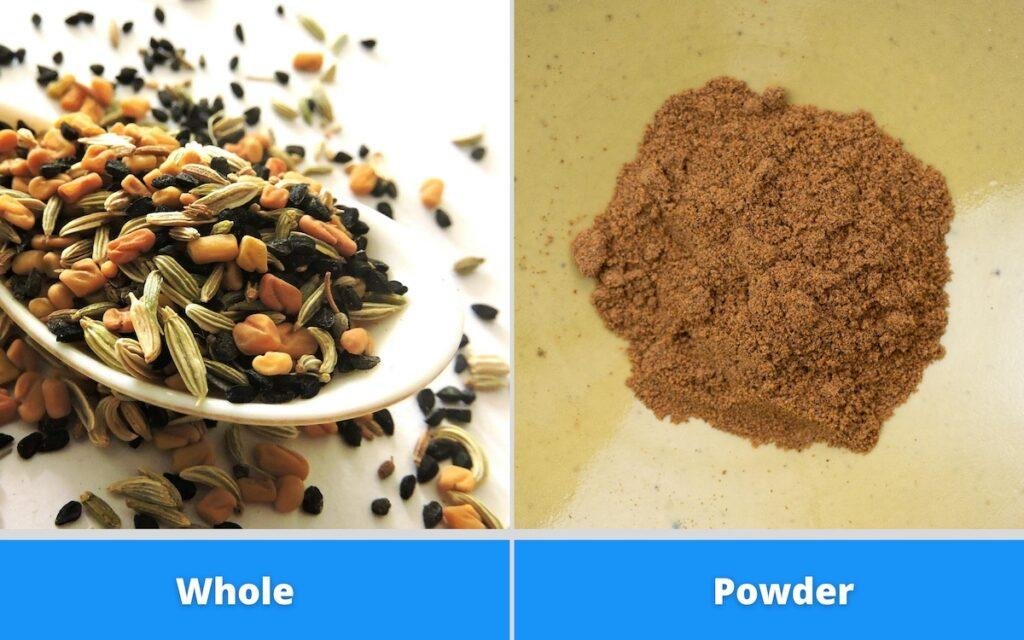
Literally, this means “five spices” in Bengali.
Yes, panch phoran is a masala from eastern India, especially West Bengal and nearby states.
So, what are the five spices needed for this mix?
The majority of Bengali chefs will tell you that the base is cumin, fenugreek, fennel, mustard, and nigella seeds.
“This is a whole-spice blend that is similar to garam masala, except that panch phoran adds texture as well as flavor,” explains Suvir Saran, author of Masala Farm.
Typically, people use whole spices, but Saran says the spices can be ground or pulverized.
After that, it can be “added to curries like the Shrimp and Sweet Corn Curry,” Saran notes.
History
Indians have been using spices forever.
“All the spices of India are closely connected to the culture, traditions and preservation since early Human History,” explain researchers Ankit Shukla and Nagendra Yadav.
In their article, published in the International Journal of Management Research & Review, they trace the trade aspect too.
For example, they note that Indians exported spices to ancient societies in Egypt, Arab countries, and China.
So, know that there is a long tradition of using these spices.
Meanwhile, did you know that Christopher Columbus was looking for spices when he “discovered” the New World?
Yes, it is true.
He was looking for pepper in India.
Health Benefits
There are many health benefits to spices.
For example, Vijaya Kumar, author of The Secret Benefits of Spices and Condiments, says there are three clear health benefits.
Kumar notes that spices have preservative, antibiotic, and therapeutic use.
In India, spices are part of the healing formula in Ayurveda, the traditional Indian medicine.
“From time immemorial, Ayurvedic kitchen spices have served a dual function of protecting and optimizing the agni and imparting incredible flavor at the same time,” explains Acharya Shunya, author of Ayurveda Lifestyle Wisdom.
Meanwhile, every spice has its own purpose, and sometimes it can work with or against other spices.
Of course, what works for someone doesn’t mean it will work for another.
“As for the curative effect of food, different ailments, life conditions, and ages may need different compositions,” explains Vinod Verma, the author of Ayurveda for Lifie.
In other words, spices are enjoyable and safe in the food of everyday life, but as medicine, they require specialized knowledge.
As a result, there experienced Ayurveda practitioners across India, and they treat all types of diseases.
That said, there are also many hybrid practitioners, meaning they practice Ayurveda and modern medicine.
Of course, there are also modern medicine practitioners who still understand the power of their traditional medicine.
Where to Buy
So, now that you learned all the good stuff about these spices, you must be asking yourself the magic question.
Where can you buy Indian spices?
It depends.
United States
The United States has millions of Indians, Pakistanis, Bangladeshis, Sri Lankans, and Nepalese.
As a result, there are many ways to purchase Indian spices, because non-Indian people of South Asia use them!
For instance, if you are in a city, then chances are there is an Indian food store not far from you.
Keep in mind that sometimes these stores are not listed online or on Google.
So, the best way to find out about them is through Indian restaurants nearby.
“I purchase my Indian spices from a shop in Queens,” says Jennifer, a woman who lives in Manhattan.
It takes her about two hours to go and back on the subway.
Likewise, in Los Angeles, Carrie buys her Indian spices a bit further, spending about 3 hours to Artesia.
“I live in North Hollywood,” says Carrie.
Artesia has over 100 Indian stores over five blocks on Pioneer Boulevard. As a result, the area is known as Little India.
“It takes about 45 minutes each way, and I usually spend an hour shopping around,” says Carrie.
Carrie makes the trip once every couple of months.
On the other hand, for Amanda in Chicago, it is entirely different.
“I walk to my Indian shop,” she laughs.
Of course, there is always Amazon, although whether you can find the right stuff is a different conversation.
To make a long story short, just shop around and see.
United Kingdom
So, all of the South Asian countries were once part of the British Empire.
As a result, the country has millions of people of South Asian ancestry, many of them British for generations.
Therefore, finding Indian spices in the UK is not an issue.
All of the cities have Indian shops, so it is just a matter of finding them.
Jackie lives in London, and she says she finds all of her Indian spices at the regular supermarkets.
“Once in a while, I will be in a place that doesn’t have that Indian section,” she says. “It is so common here,” she adds.
Dylan in Manchester says he lives in a neighborhood with fewer Indians, and he says it is not difficult either.
“I have a shop about ten minutes’ walk from my house,” says Dylan.
Although Manchester has a lot of Indians, Dylan notes that the region is the least with Indians.
“Northwest England is very white,” he laughs.
It is the same story for Oliver in Glasgow.
He says that the city has a lot of Indians but not the region.
However, he also has no problem finding Indian spices.
“I used to have a hard time finding pancho phoran,” says Oliver. “Scotland doesn’t have a huge Bengali population,” he adds. “We have more North Indians and Pakistanis. So, that makes it a bit harder.”
Sometimes, you might not find every kind of spice, but generally, the UK has a lot of options.
Meanwhile, like Americans, Brits have access to Amazon and can easily order stuff from the large e-commerce platform.
Canada
So, Canada has a lot of people of South Asian ancestry!
And they are not a tiny minority, because about 10% of Canadians have South Asian backgrounds.
So, it is not that difficult to find Indian spices.
Richard lives in Brampton, a suburb of Toronto where the population has 50% of people of South Asian ancestry.
“I have no problem at all to find Indian spices,” says Richard. “I work at the airport, so I moved to the area for that,” he adds. “However, I love Punjabi spices, and it is so easy to find it here. So, happy about that!”
Likewise, a woman named Charlotte in Surrey, a suburb of Vancouver, says finding Indian spices is also easy.
“We have a large community of Indians here,” says Charlotte. “No trouble at all.”
Surrey has about 30% of people of South Asian background.
Meanwhile, Sophie in Dollard-des-Ormeaux, a suburb of Montreal, reports the same.
“I love making Indian food, and there is plenty of Indian places to shop here,” she says.
Like the Americans and British, Canadians also have their own local Amazon store and can easily order spices.
Australia
Because of its proximity to Asia, Australia has tons of South Asians.
Cities like Sydney, Melbourne, and Perth all have easy access to Indian spices, as there are many South Asian shops.
Of course, Australians also have Amazon, and through that, it is readily available.
Worldwide
Of course, there are a lot of countries where there aren’t many South Asians.
As a result, it may be a bit more difficult to find Indian spices.
So, what is the solution?
Order them online!
There are global platforms like Amazon, which deliver worldwide!
For example, Amazon delivers to more than 100 countries.
It is because they have centers worldwide.
Amazon North America (US, CA), Europe (UK, FR, DE, ES, IT, etc.), and Australia (AU).
Likewise, there are Amazon centers in Asia (IN, JP, etc.), South America (BR), and proposed spots in Africa (SA, KE, etc.).
Final Thoughts
Indian Spices are the backbone of Indian food because they give Indian food its diverse flavors.
Of course, India is a big country, and the regional differences are significant.
As a result, I covered four regional spice mixes in this article, as well as three national spices.
They constitute, as far as I’m concerned, the essential spices from India.
Now that you know the names and even how they look, it is time to stock them in your kitchen!
Good luck.
Nina Walker is a food writer for Caravanzers.
Follow us on Pinterest.
